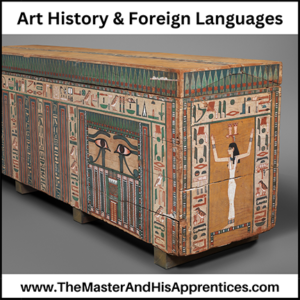The Interconnectedness of Art History & Foreign Language Studies
The Art History and Foreign Language Connection:
Art history and foreign language studies are often integrally connected. In fact, most graduate-level art history degrees require the study of one or more foreign languages.
Why? Because art history students who achieve a reading level or higher in a foreign language often come to better understand the history and culture of their art period of choice. Art is not created in a vacuum, rather it is greatly influenced by many factors surrounding it – language included.
Moreover, art historians can acquire a deeper understanding of the texts they use in their research. For instance, they can read private journal entries or letters written by the artist(s) they are studying. Often, these hard-to-come-by texts must be read on location (estates, museums, etc.) because they are unavailable elsewhere.
Moreover, some of the world’s greatest works of art include written text WITHIN the art. A few examples included in The Master and His Apprentices art history textbook include the Law Code of Hammurabi (Akkadian), the Ramses II Temples at Abu Simbel (Ancient Egyptian), the Arch of Titus (Latin), the Dome of the Rock (Arabic), the Rök Stone (Runes), and the Limbourg Brother’s illuminated manuscripts (French).
Art history students have a broad range of foreign languages to choose from, depending on their area of interest. French, Italian, and German are especially popular modern languages related to European art. Classical Greek and Latin are great choices for the classical periods. And languages like Akkadian and Egyptian Hieroglyphs are especially helpful when focusing on an ancient period.
Learning a Foreign Language:
If your child wants to learn a foreign language, then now is the time to begin! Experts agree that learning a foreign language while still young is ideal. Homeschoolers often have more flexibility in their class choices, so this can be a great way to customize language learning with a child’s interests – whether that be art history or something else.
Thanks to technology, learning a foreign language has never been easier. Students can quickly lay a foundation with language programs like Rosetta Stone. They can increase vocabulary acquisition while perusing online news sources or article databases. Later, they can converse live with a native speaker through online platforms like Verbling.
Until recently, students of modern and classical languages had an edge in quality resources and homeschool language opportunities. However, www.Ancient-Languages.com is helping to fill the ancient language gap with live classes for homeschooled teens in Biblical Hebrew, Akkadian (cuneiform), and Middle Egyptian (hieroglyphs).
All around, homeschooled students have a lot of options when it comes to foreign language studies.
In Conclusion:
Many people do not realize the significance that foreign languages play in advancing art history studies. If your child has completed The Master and His Apprentices: Art History from a Christian Perspective and wants to pursue art history studies further, consider studying a foreign language. Simply choose the language that best aligns with your child’s art history area of interest. There has never been a time to combine art history and foreign language studies with so many great opportunities available for homeschooled students!
